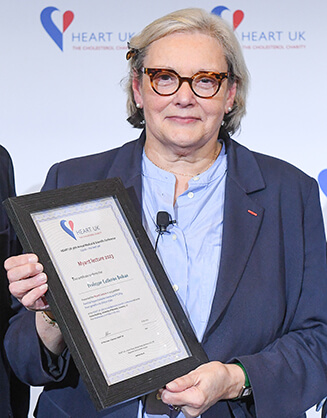HEART UK held its 36th Annual Medical and Scientific Conference over several days in July 2023 when the cholesterol charity reflected on the current progress across a range of key areas within lipidology. This included an update on the progress in cardiovascular disease (CVD) prevention nationally, paediatric familial hypercholesterolaemia (FH) and a look back on the dramatic progress since the identification of PCSK9 as a lipid treatment target. Dr Andreas Tridimas reports its highlights.
CVD prevention past and present

The scale of CVD deaths, currently 136,000 per year in the UK1 and similar in number to the first year of the COVID-19 pandemic, was highlighted by Dr Shahed Ahmad (NHS England) in his role as National Clinical Director for CVD. He emphasised the importance of tackling CVD as if it were a pandemic. Rather than needing to create vaccines, he said we already have the necessary therapeutics to reduce CVD but these need robust application to our populations. He signposted the CVDPREVENT website2 with its wealth of open access primary care data on metrics, such as the percentage of adult patients with CVD on lipid-lowering therapy, which currently stands at 81%. He used examples to highlight the significant unwarranted clinical variation across geographical areas, emphasising the need to tackle regional variation.
Professor Azfar Zaman (Newcastle Hospitals NHS Foundation Trust) outlined the impressive reductions in ischaemic heart disease deaths over the last two decades when compared with other causes, such as malignancy and influenza. Importantly, he stressed the need to consider the impact of morbidity from CVD events and not simply focus on mortality data.3 Regarding CVD pathophysiology, he reiterated the well-established factors driving its development such as diabetes, inflammation, and dyslipidaemia. He then stressed the point that amplified benefits are seen when we intervene to address the multiple causal pathologies for CVD development, as opposed to focusing on risk factors in isolation.
Rheumatoid arthritis and CVD risk
In rheumatoid arthritis the principal driver of the increased mortality seen is CVD.4 This important point was made rheumatologist Professor Ernest Choy (Cardiff University). Lipid levels are only part of the picture, he said, and inflammation appears to drive the process of CVD development.5 Furthermore, during relapses, lipid levels in rheumatoid arthritis may actually appear lower, with a rise seen after successful treatment. This is thought to reflect lipids behaving as negative acute phase reactants,6 which he compared to the lower cholesterol levels that have long since been recognised following acute myocardial infarction.7
Paediatric familial hypercholesterolaemia
Mrs Lorraine Priestley-Barnham (Harefield Hospital), a Paediatric FH Clinical Nurse Specialist, made the key point that children can have high cholesterol too. It is estimated that there are approximately 50,000 children with FH under 18 years in the UK, based on the population prevalence of one in 250.8 Much of our focus to date, she said, has been on adults with FH. She stressed the importance of starting treatment early in life, supported by multiple long-term studies that show statin safety in children.8 She directed the audience to the HEART UK statement of care for paediatric FH as a resource to guide clinical teams.8
Diet in CVD prevention – a tool to help assess diet
Less than 0.1% of people adhere to the Public Health England Eatwell guide,9 Consultant Nutritionist Ms Elphee Medici (London) told the meeting, showing the extent of poor diet in the UK. She showcased the ‘HEART UK Cardiovascular Diet Checklist’10 as a tool to help clinicians and patients to assess diet. This uses 16 yes/no questions to provide an indication of whether a diet is ‘heart healthy.’ Top-line practical feedback is provided on completion to help navigate towards dietary improvement. The HEART UK team is currently updating the online checklist to provide more tailored advice and help motivate individuals to make dietary improvements.

CVD prevention services and managing workload
Professor Gordon Ferns (Brighton and Sussex Medical School) and Dr Tina Khan (Harefield Hospital) looked at how to manage workload for CVD prevention services. Professor Ferns used his local experience to draw attention to the rising tide of lipid clinic referrals resulting from factors such as new lipid-lowering therapies and treatment guidelines. He outlined how this has led to his service having to implement strategies to ensure the service remains sustainable. Dr Kahn outlined her team’s adaptive approach to dealing with referral volume, which has included upskilling specialist nurses to oversee referral triage, as well as lipid education sessions, webinars and MDT collaborations.
PCSK9: from genetics to clinical trials

The prestigious Myant lecture this year was given by Professor Catherine Boileau (Hôpital Bichat-Claude Bernard, Paris, France), who was a key figure in the identification of PCSK9 as a treatment target. Professor Boileau started her talk by illustrating some of the earliest historic evidence of lipid disorders with xanthelasma seen on Da Vinci’s Mona Lisa and tendon xanthoma on the Charioteer of Delphi.11
From ancient Greece to modern day, Professor Boileau and her team first showed in 2003 how mutations in PCSK9 cause autosomal dominant hypercholesterolaemia.12 In 2006 came evidence that sequence variations in PCSK9 led to lower low-density lipoprotein and protection against coronary heart disease.13 What followed was a flurry of scientific development and, within 12 years of Professor Boileau’s study, the first PCSK9 inhibitor, alirocumab, was approved for clinical use in what many regard as the pharmacotherapeutic innovation of the decade for CVD prevention.
Dr Andreas Tridimas
Consultant in Chemical Pathology & Metabolic Medicine
Countess of Chester Hospital and Wirral University Teaching Hospital
a.tridimas@nhs.net
References
1. The Kings Fund. Cardiovascular disease in England. Supporting leaders to take actions. November 2022. https://www.kingsfund.org.uk/sites/default/files/2022-11/CVD_Report_Web.pdf (last accessed 4/8/2023)
2. Office for Health Improvement and Disparities and the NHS Benchmarking Network. Cardiovascular Disease Prevention Audit (CVDPREVENT). NHS Digital 2021. https://www.cvdprevent.nhs.uk/home (Last accessed 4/08/2023)
3. Cheema KM, Dicks E, Pearson J et al. Long-term trends in the epidemiology of cardiovascular diseases in the UK: insights from the British Heart Foundation statistical compendium. Cardiovasc Res 2022;118:2267–80. https://doi.org/10.1093/cvr/cvac053
4. Gabriel SE. Why do people with rheumatoid arthritis still die prematurely? Ann Rheum Dis 2008;67(Suppl 3):iii30–4. https://doi.org/10.1136/ard.2008.098038
5. Del Rincón ID, Williams K, Stern MP et al. High incidence of cardiovascular events in a rheumatoid arthritis cohort not explained by traditional cardiac risk factors. Arthritis Rheum 2001;44:2737–45. https://doi.org/10.1002/1529-0131(200112)44:12<2737::AID-ART460>3.0.CO;2-%23
6. Choy E, Sattar N. Interpreting lipid levels in the context of high-grade inflammatory states with a focus on rheumatoid arthritis: a challenge to conventional cardiovascular risk actions. Ann Rheum Dis 2009;68:460–9. https://doi.org/10.1136/ard.2008.101964
7. Watson WC, Buchanan KD, Dickson C. Serum cholesterol levels after myocardial infarction. BMJ 1963;2:709–12. https://doi.org/10.1136/bmj.2.5359.709
8. Ramaswami U, Humphries SE, Priestley-Barnham L et al. Current management of children and young people with heterozygous familial hypercholesterolaemia – HEART UK statement of care. Atherosclerosis 2019;290:1–8. https://doi.org/10.1016/j.atherosclerosis.2019.09.005
9. Scheelbeek P, Green R, Papier Keren A et al. Health impacts and environmental footprints of diets that meet the Eatwell Guide recommendations: analyses of multiple UK studies BMJ Open 2020;10:e037554. https://doi.org/10.1136/bmjopen-2020-037554
10. HEART UK – The Cholesterol Charity. HEART UK Diet checklist. https://www.heartuk.org.uk/national-cholesterol-month/diet-checklist (Last accessed 4/8/2023)
11. Durrington, PN. The first recorded heterozygote for familial hypercholesterolemia. J Clin Lipid 2009;3:146–8. https://doi.org/10.1016/j.jacl.2009.02.002
12. Boileau C, Abifadel M, Varret M et al. Mutations in PCSK9 cause autosomal dominant hypercholesterolemia. Nat Genet 2003;34:154–6. https://doi.org/10.1038/ng1161
13. Cohen JC, Boerwinkle E, Mosley TH Jr et al. Sequence variations in PCSK9, low LDL, and protection against coronary heart disease. N Engl J Med 2006;354:1264–72. https://doi.org/10.1056/NEJMoa054013
